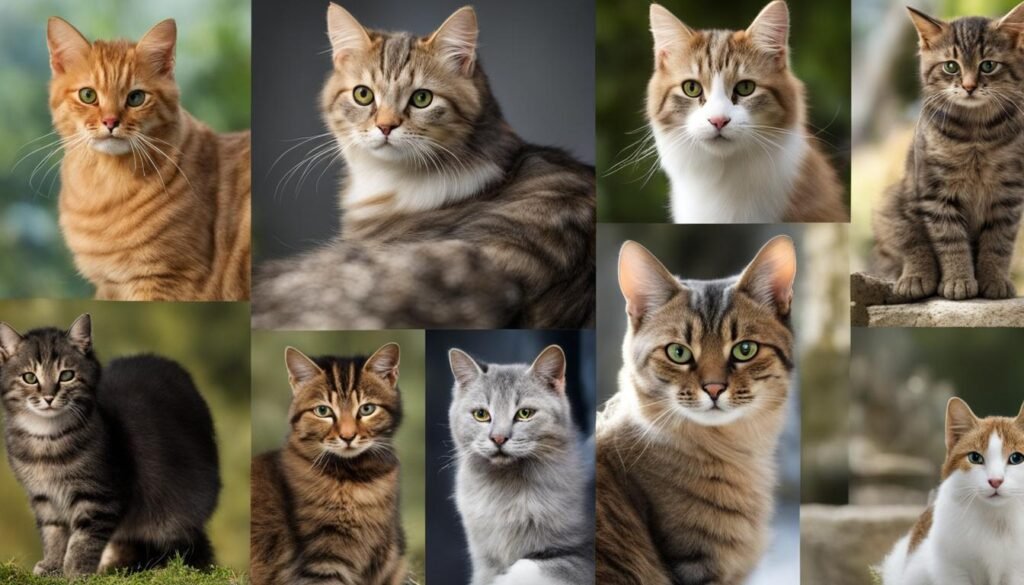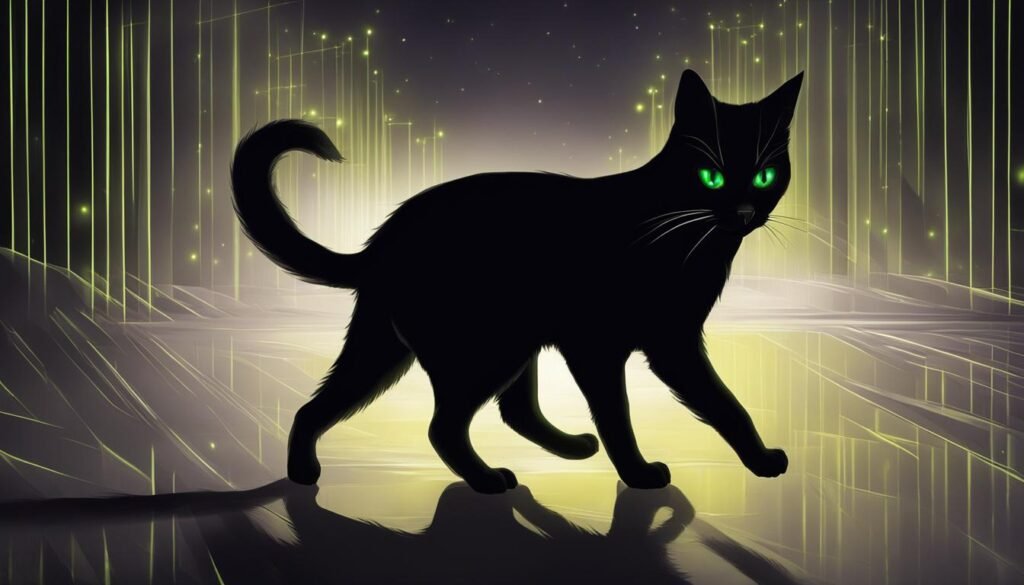Welcome to our fascinating exploration of the ancient cat domestication and the early connections between cats and humans. Cats, descendants of the African wildcat, have shared a special relationship with humans for thousands of years. In this article, we will delve into the intriguing history and significance of this bond, shedding light on the mysteries that surround ancient cat domestication.
Key Takeaways:
- Ancient cat domestication dates back approximately 9,000 years in the Near East.
- Cats played a crucial role in protecting crops against rodents.
- The relationship between cats and humans has evolved over time, spreading across different cultures.
- Cats have become cherished companions, offering comfort and support to their owners.
- Understanding the history and significance of cats enhances our appreciation of the animal kingdom and strengthens our bond with these fascinating creatures.
Evolution and Domestication
Cats, scientifically known as Felis catus, have a fascinating evolutionary journey that led to their domestication. These beloved feline companions evolved from the African wildcat, Felis lybica, which inhabited parts of Asia and Africa. Over time, humans and wildcats developed a mutualistic relationship, leading to the domestication of cats.
The domestication of cats began around 9,000 years ago in the Near East, where early agricultural communities recognized their value in protecting crops against rodents. Cats proved to be adept hunters, effectively controlling the rodent population and safeguarding valuable food supplies. This symbiotic relationship between humans and cats paved the way for cats to become cherished companions.
As humans migrated and traded goods, cats quickly spread across the globe. They found homes in various cultures and landscapes, adapting to different environments and establishing themselves as integral members of households. Domesticated cats have since evolved into a diverse array of breeds, each with unique physical characteristics and temperaments.

The Domestication of Cats: Key Points
- Cats evolved from the African wildcat (Felis lybica).
- Domestication began around 9,000 years ago in the Near East.
- Cats were valued for their role in protecting crops against rodents.
- They spread across the globe and became cherished companions.
- Domesticated cats have evolved into a diverse range of breeds.
“The domestication of cats is a testament to the unique bond that can form between humans and animals. From their origins in the wild to becoming our beloved companions, cats have woven themselves into the tapestry of human history.”
In the next section, we will explore the fascinating anatomy and physiology of cats, delving into the remarkable characteristics that contribute to their hunting prowess and agility.
Anatomy and Physiology
Cats possess incredible physical attributes that contribute to their prowess as hunters. From their sharp retractable claws to their exceptional night vision, cats are expertly equipped to navigate their environment with agility and precision.
One of the standout features of cats is their sharp retractable claws. These claws allow them to silently stalk and capture prey without alerting their target. While at rest, the claws are retracted to keep them sharp and protected. When needed, cats can extend their claws to effectively grip surfaces and maintain balance.
Cats also possess remarkable night vision, thanks to their unique eye structure. Their elliptical pupils dilate to allow more light to enter the eye, enhancing their ability to see in low-light conditions. In addition, cats have a reflective layer behind their retinas called the tapetum lucidum, which boosts their vision even further by reflecting light back through the eyes.
Agility and flexibility are key traits that enable cats to execute incredible feats of acrobatics. Their bodies are built for quick, precise movements, with strong hind legs that provide power for pouncing and leaping. Cats also have a flexible spine that allows them to contort their bodies, enabling them to squeeze through small spaces or twist during mid-air maneuvers.

With their sharp retractable claws, exceptional night vision, and impressive agility and flexibility, cats are truly remarkable creatures when it comes to their anatomy and physiology.
Communication and Social Behavior
Understanding the communication and social behavior of cats can provide valuable insights into their complex nature. Cats have developed an intricate system of communication, utilizing vocalization, body language, and scent marking to convey messages to other cats and their human companions.
Cat vocalizations can vary greatly, from the familiar meow to purring, hissing, growling, and even chirping. Each sound carries a specific meaning, such as seeking attention, expressing contentment, or indicating aggression. Paying attention to these vocal cues can help cat owners better understand and respond to their furry friends’ needs.
In addition to vocalizations, cats rely on body language to communicate. They use subtle cues such as tail positioning, ear position, and facial expressions to express their emotions and intentions. For example, a raised tail indicates confidence, while a tucked tail signifies fear or submission. Understanding these nonverbal cues can foster better communication and strengthen the bond between cats and their human companions.
Scent marking is another important aspect of cat communication. Cats possess scent glands in various parts of their body, including the cheeks, paws, and tail. By rubbing against objects or individuals, they leave behind their unique scent, marking their territory and communicating with other cats. This behavior helps establish social hierarchies and facilitates social interactions among feline groups.
Social Behavior
Contrary to popular belief, cats are social animals that thrive on companionship. While they may have an independent reputation, cats form social bonds with other cats and even their human caregivers. They engage in various social behaviors such as grooming each other, playing, and engaging in mutual activities. These interactions help provide mental stimulation and promote social well-being for cats.
It is important for cat owners to recognize and respect their feline companions’ social needs. Providing opportunities for socialization, such as playtime, interaction with other cats, and positive human-cat interactions, can greatly enhance their overall well-being and happiness.
Cat Communication and Social Behavior Table
| Communication Method | Description |
|---|---|
| Vocalization | Includes meowing, purring, hissing, growling, and chirping. Each sound conveys a specific message or emotion. |
| Body Language | Uses tail positioning, ear position, facial expressions, and overall body posture to express emotions and intentions. |
| Scent Marking | Occurs through rubbing objects or individuals to leave behind their unique scent, marking territory and communicating with other cats. |
| Social Behavior | Includes grooming, playing, and engaging in mutual activities with other cats or human companions, promoting social well-being. |
The Emotional Lives of Cats
When it comes to emotions, cats are more complex creatures than they are often given credit for. Despite their independent nature, cats can experience a range of emotions similar to humans. They can feel fear, happiness, contentment, and even grief.
One of the most remarkable aspects of cats’ emotional lives is the bond they form with their human caregivers. Cats have the capacity to develop deep connections with their owners, often displaying affection and seeking comfort and companionship. This bond can be so strong that cats can experience separation anxiety when their owners are away for extended periods.
Not only do cats have the ability to form emotional connections with humans, but they are also sensitive to their environment and the emotions of those around them. They can pick up on subtle cues and provide comfort and support when their owners are feeling down or stressed. Many cat owners have experienced the soothing presence of their feline companions during difficult times.
“Cats are like little emotional barometers, responding to our moods and emotions in their own unique ways. Their empathy and ability to provide comfort is truly remarkable.”
The Benefits of the Human-Cat Bond
The bond between cats and humans is not only emotionally fulfilling but also has a positive impact on our well-being. Research has shown that interacting with cats can reduce stress levels and lower blood pressure. Cats’ purring has even been shown to have a calming effect on their owners, promoting relaxation and a sense of well-being.
As companions, cats not only provide emotional support but also promote a sense of responsibility and routine. Taking care of a pet can give people a sense of purpose and provide structure to their day. For those living alone or with limited social interactions, the companionship of a cat can help alleviate feelings of loneliness and provide a source of social connection.
| Benefits of the Human-Cat Bond | Emotional Support | Stress Reduction | Lower Blood Pressure |
|---|---|---|---|
| Companionship | ✔️ | ✔️ | ✔️ |
| Sense of Purpose | ✔️ | ✔️ | ✔️ |
| Social Connection | ✔️ | ✔️ | ✔️ |
The Curious Habits of Cats
Cats are known for their quirky and fascinating behaviors. From their kneading motions to their obsession with boxes, cats never fail to surprise and entertain us. Let’s take a closer look at some of these curious habits.
Kneading Behavior
One of the most endearing and peculiar behaviors of cats is kneading. This is when cats rhythmically push their paws in and out against a soft surface, often accompanied by purring. It’s a behavior that cats develop as kittens when nursing, and it carries over into adulthood as a way to show contentment and mark their territory with the scent glands in their paws.
Fascination with Boxes
It’s no secret that cats love boxes. Whether it’s a small cardboard box or a large shipping box, cats can’t resist squeezing themselves into these confined spaces. This behavior stems from their natural instincts as predators. Boxes provide a sense of security and serve as hiding spots or vantage points for observing their surroundings.
Grooming Behavior
Cats are known for their meticulous grooming habits. They spend a significant amount of time licking their fur, which serves multiple purposes. Grooming helps cats maintain a clean and healthy coat, remove loose hair, and distribute natural oils. It’s also a form of self-soothing and relaxation for cats, similar to how humans might engage in activities like yoga or meditation.
| Curious Habits | Explanation |
|---|---|
| Kneading Behavior | Cats knead to mark their territory and show contentment. |
| Fascination with Boxes | Boxes provide cats with security and serve as hiding spots. |
| Grooming Behavior | Grooming helps cats maintain a clean coat and provides relaxation. |
These curious habits are just a few examples of the unique behaviors that make cats so intriguing. Whether they’re kneading, exploring boxes, or indulging in grooming sessions, cats never cease to bring joy and wonder to our lives.
The Mysterious World of Cat Perception
Cats possess an array of extraordinary sensory abilities that contribute to their fascinating perception of the world. Their keen senses of sight, hearing, and smell allow them to navigate their environment and interact with it in unique ways.
Keen Sight in Cats
Cats are known for their exceptional vision, particularly in low light conditions. Their eyes contain a higher concentration of rod cells, specialized photoreceptors that enable them to see in dim lighting. This adaptation is a result of their evolutionary history as nocturnal hunters. The slit-shaped pupils of their eyes can quickly adjust to changes in light intensity, allowing them to focus and track prey with precision.
Acute Hearing Abilities
One of the most remarkable features of cats is their acute hearing. They have an extensive range of audible frequencies, which surpasses that of humans and even some other animals. Cats can rotate their ears independently to locate the source of sounds accurately. This ability, combined with their sensitive inner ear structures, enables them to detect subtle noises, such as the rustling of small prey or the softest footsteps.
Powerful Sense of Smell
The sense of smell in cats is highly developed and plays a crucial role in their perception of the world. They possess an impressive number of olfactory receptors, allowing them to detect and distinguish a wide range of scents. Cats rely heavily on their sense of smell for communication, marking territories, and identifying potential prey or predators. Their ability to pick up on subtle odors and pheromones enhances their understanding of the environment.
| Sense | Description |
|---|---|
| Sight | Cats have exceptional night vision and can perceive slight movements. |
| Hearing | Cats possess acute hearing abilities and can locate the source of sounds accurately. |
| Sense of Smell | Cats have a powerful sense of smell, enabling them to detect and distinguish various scents. |
These remarkable sensory abilities contribute to cats’ unique perception of the world. Their keen sight, acute hearing, and powerful sense of smell enable them to navigate their surroundings with precision and engage in their natural behaviors as skilled predators. Understanding and appreciating the fascinating world of cat perception enhances our admiration for these captivating creatures and deepens our connection with them.
Conclusion
Cats have a captivating history as domesticated companions. Descended from the African wildcat, they were first domesticated in the Near East around 9,000 years ago. Throughout the centuries, cats have proven to be more than just adorable pets, but valuable protectors of crops and cherished members of households worldwide.
Cats possess unique qualities and behaviors that make them fascinating creatures. Their evolution from the African wildcat and their ability to communicate through vocalization, body language, and scent marking showcase their intelligence and adaptability. Despite their independent reputation, cats are social animals and form strong bonds with their human caregivers.
Understanding the emotional lives of cats is crucial in appreciating their significance as companions. Cats experience a range of emotions, from happiness and contentment to fear and grief. Their sensitivity to their environment allows them to provide comfort and support to their owners, fostering a deep and meaningful bond.
Exploring the habits and perceptions of cats further enriches our understanding of these remarkable creatures. Whether it’s their kneading behavior, fascination with boxes, or meticulous grooming rituals, cats’ unique instincts and therapeutic effects continue to captivate and entertain us. Their exceptional senses of sight, hearing, and smell further enhance their abilities as hunters and companions.
FAQ
What is the history of cat domestication?
Cats, descendants of the African wildcat, were first domesticated around 9,000 years ago in the Near East.
How did cats contribute to early human civilizations?
Cats served as valuable protectors of crops against rodents and spread across the globe to become cherished companions.
What unique anatomy do cats have?
Cats have sharp retractable claws for silent stalking, exceptional night vision, strong hind legs for pouncing and leaping, a flexible spine for contorting their bodies, and a keen sense of balance.
How do cats communicate?
Cats have an intricate system of communication involving vocalization, body language, and scent marking. They can produce a wide range of sounds and use body language to convey specific messages.
Are cats social animals?
Despite their independent reputation, cats are social animals and engage in various forms of social behavior.
What emotions do cats experience?
Cats experience a range of emotions, including fear, happiness, contentment, and grief. They form strong bonds with their human caregivers and can exhibit separation anxiety.
What are some quirky behaviors of cats?
Cats have unique and quirky behaviors, such as kneading, which is a rhythmic paw motion often accompanied by purring. They are also fascinated with enclosed spaces like boxes and dedicate time to grooming themselves.
What are the sensory abilities of cats?
Cats have exceptional sight in dim light, highly developed hearing, and a strong sense of smell. Their vision allows them to perceive even slight movements, their ears can rotate independently for accurate sound location, and their olfactory receptors are more potent than humans’.
What is the significance of cats in history and as companions?
Cats have a captivating history as domesticated companions. They are descended from the African wildcat and were first domesticated in the Near East. Cats have unique qualities and behaviors that have made them beloved members of households worldwide.
